#rhamphorhynchoid
Photo
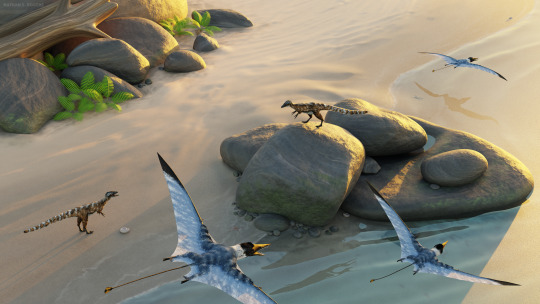
Solnhofen Sunrise 01
Late Jurassic, Europe
Compsognathus dinosaurs explore the early morning beach as Rhamphorhynchus pterosaurs fly by, perhaps returning from a night of fishing?
Made in Blender.
#compsognathidae#compsognathus#Rhamphorhynchus#rhamphorhynchoid#blender#3d#digital art#pterosaur#dinosaur#paleoart#paleontology#Jurassic#beach#morning
108 notes
·
View notes
Text
i went on a deep dive of how pterosaur wings folded (i forgor why) and apparently its all fucked up
#so like the 'bat wing' structure apparently applies to rhamphorhynchoids (smaller and with longer tails) but not pterodactyloids#(later ones) or something? idk i find semi conflicting info#i cant find clear tings on exactly HOW they walked or how they folded >:( I NEEDED THAT#hmmm feminine urge to study paleontology coming back. just a tiny bit...
2 notes
·
View notes
Text
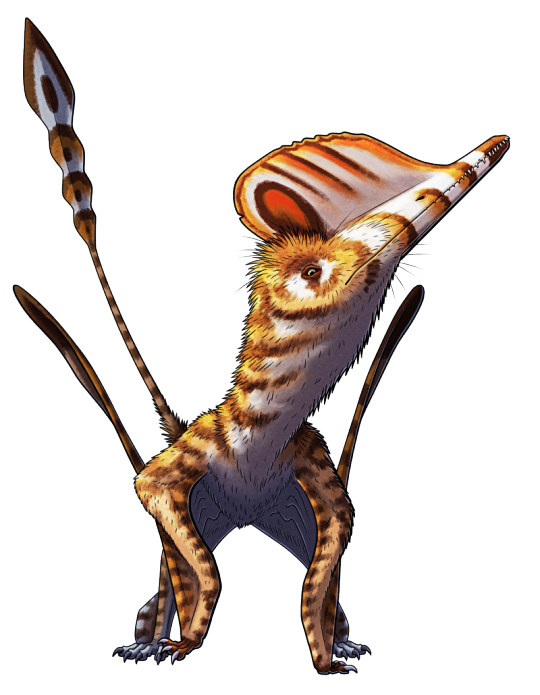

Wukongopterus lii was a pterosaur that lived during the mid-to-late Jurassic, about 164 million years ago, in what is now northeastern China. It was fairly small, with a wingspan of around 70cm (~2'4"), and showed a mixture of anatomical features in-between the long-tailed short-headed 'rhamphorhynchoids' and the short-tailed long-headed pterodactyloids.
Its long jaws were lined with tiny pointed conical teeth, suggesting it was adapted for primarily feeding on insects. It also had a very slight overbite, with the first two pairs of teeth in its upper jaw protruding almost vertically over the end of its lower jaw.
As a fully mature adult it would have had a low bony crest on its head that probably supported a larger keratinous structure – similar to other known wukongopterids – although the exact size and shape is unknown since the one confirmed specimen of Wukongopterus is missing that particular part of its skull. Another fossil nicknamed "Ian" may represent a second individual of this species, showing a different crest arrangement further forward on its snout, so I've made two different versions of today's image to reflect that possibility.
———
NixIllustration.com | Tumblr | Patreon
References:
Cheng, Xin, et al. "New information on the Wukongopteridae (Pterosauria) revealed by a new specimen from the Jurassic of China." PeerJ 4 (2016): e2177. https://doi.org/10.7717/peerj.2177/supp-1
Garland, Nick. “Ian the Wukongopterid.” Pteros, https://www.pteros.com/pterosaurs/ian-the-wukongopterid.html
Wang, Xiaolin, et al. "An unusual long-tailed pterosaur with elongated neck from western Liaoning of China." Anais da Academia Brasileira de Ciências 81 (2009): 793-812. https://doi.org/10.1590/S0001-37652009000400016
Wikipedia contributors. “Wukongopterus.” Wikipedia, 8 Dec. 2023, https://en.wikipedia.org/wiki/Wukongopterus
XuanYu Zhou 周炫宇. Anatomy, Systematics and Paleopathology of Pterosaurs: insights based on new specimens from China. 2023. Hokkaido University, PhD thesis. https://doi.org/10.14943/doctoral.k1560
#science illustration#paleontology#paleoart#palaeoblr#wukongopterus#wukongopteridae#monofenestrata#pterosaur#art
296 notes
·
View notes
Note
Okay, so, I don't know how much specific interest you may or may not have in pterosaurs, I can't recall seeing you mention them before (but also my memory is... ummm...).
So basically, which gender are you, rhamphorhynchoid or pterodactyloid?
As with any favorite or binary choosing question, especially about gender and extinct life, I can't choose! But if I had to, I would choose rhamphorynchoids. They're honestly cute in a way, and so much more elegant than those dirty, clumsy looking, dopey pterodac- *stabbed*
Agh
Oh god
Oh no
Oh fuck

All glory to Pterodactyloidea.
All glory to Tapejara.
All glory to Hatzegopteryx.
All glory to Quetzalcoatlus.
All glory to Azhdarchoidea.
33 notes
·
View notes
Text

The Magnificent Langoon
the largest animal ever to fly the great lance dragon or langoon are giant Rhamphorhynchoid pterosaurs that rule over saikin with a serrated beak and powerful claws these animals are capable of hunting prey up to a ton or more in weight The langoon are most similar to the long extinct azdarchids in appearance and indeed hunt on the ground in a similar fashion yet perhaps surprisingly these animals are far closer to Genera like Harpactognathus than any Azdarchoid
These Giants of the skies are well known for their often dragon like behavior Its well documented that langoons will often steal pretty or shiny objects for a bower like nest structure which is utilized by males to attract mates in fact when the saikin subspecies was formally described in 1836 it was noted that females chose bowers that had the most impressive items with megafauna skulls and strange rocks being preferred by females
#spec evo#speculative evolution#speculative zoology#speculative biology#original species#pterosaur#worldbuilding#spec council
39 notes
·
View notes
Note
I noticed all the pterosaurs in PP were the toothless short-tailed variety. Did the long-tailed toothy ones already die out by the late Cretaceous?
Yep, and not just the long-tailed toothy pterosaurs, but almost all pterosaur groups seem to have gone extinct before the end of the Cretaceous! The only remaining pterosaurs (that we know of) were all pterodactyloids, or "short-tailed" pterosaurs. Most pterodactyloids did also have teeth (like Pterodactylus itself for example), but by 66 million years ago only two groups were left, both toothless, and those are the ones that show up in Prehistoric Planet.
There's Pteranodontia, which includes Nyctosauridae (represented in PP by Barbaridactylus and Alcione) and Pteranodontidae (represented by Tethydraco).

And there's Azhdarchidae, which is represented in Prehistoric Planet by Phosphatodraco, the unnamed Mongolian azhdarchids, Quetzalcoatlus, and Hatzegopteryx.

The long-tailed toothy ones used to be grouped together as "rhamphorhynchoids", but this is an unnatural grouping that lumped together early pterosaurs, dimorphodontids, anurognathids and rhamphorhynchids based on them being seen as "more primitive". It's not really a scientifically useful group, but yeah by the Maastrichtian stage of the Cretaceous everything that wasn't a pteranodont or an azhdarchid seems to have been gone.
#prehistoric planet#prehistoric planet spoilers#pterosaurs#paleontology#paleoart#paleomedia#palaeoblr
183 notes
·
View notes
Photo
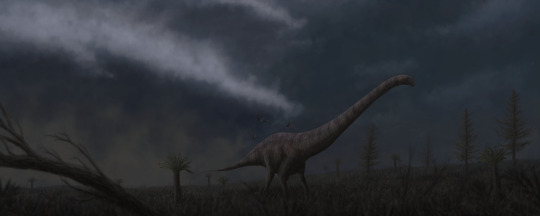
Despite it's immense size, the aptly named giant sauropod Supersaurus vivianae is dwarved in comparison to an approaching storm.
This scene takes place in the Morrison Formation of Colorado, 153 million years ago.
#my art#paleoart#supersaurus#vivianae#sauropod#dinosaur#extinct#animal#jurassic#nature#prehistoric#colorado#morrison formation#sciart#paleontology#rhamphorhynchoid#pterosaur#diplodocidae#storm#atmospheric#longneck
112 notes
·
View notes
Text

#dinosaur#dinosaurs#dino#pterosaurs#pterosaur#Dimorphodon#mesozoic#jurassic#jurassic period#richard owen#Pterosauria#dinosaur art#paleo art#paleontology art#Dimorphodontia#rhamphorhynchoid#Dimorphodon macronyx#Dimorphodontidae#Caelestiventus#dinosaur tumblr#dinosaur tumblrs#flying reptiles#mesozoic art#jurassic art#mesozoic era#paleontology#art#extinct creature#pterosaur art#extinct animal
22 notes
·
View notes
Text
Hello everyone! Welcome to an educational post about pterosaurs!
I’m a massive fan of pterosaurs, so I always get sad when they’re misrepresented in media, and they almost always are. So today I’m going to clear up some misconceptions about pterosaurs, as well as take you guys through some different species that I find interesting.

Art credit: Chase Stone
Firstly, what are pterosaurs?
Let’s get it out of the way- pterosaurs are not flying dinosaurs. They are thought to be more closely related to dinosaurs than to any other animal, but they are not true dinosaurs. Both dinosaurs and pterosaurs belong to a group called the archosaurs, which were the group of animals that dominated the land in the mesezoic.
For those of you who are more visually inclined, here’s the incredibly oversimplified version of where pterosaurs sit on the reptile family tree:
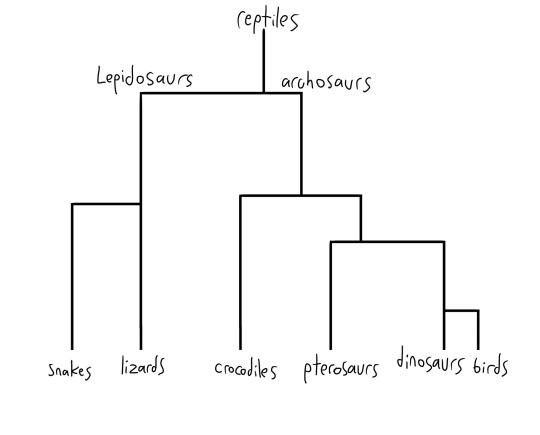
Pterosaurs themselves can be split into two main groups, rhamphorhynchoids and pterodactyloid pterosaurs.

Art credit: Christian Klug
Rhamphorhynchoids were the earlier kind of pterosaurs, and lived from the late Triassic to early Jurassic. They were smaller, and they had features like teeth and long tails that later pterosaurs lacked. Members of this group include rhamphorhynchus, dimorphodon, and caelestiventus.

Art credit: Simon Stalenhag
Pterodactloid pterosaurs were the later kind, living from the Jurassic to the end of the Cretaceous. Their size ranged from small bird to fighter jet. They lacked long tails, and despite their portrayals in media, most lacked any form of teeth. This group was much more diverse, and in my opinion, more interesting.
Here’s something more people should know about! Pterosaurs didn’t have the leathery skin that is often portrayed in media. Like many dinosaurs, pterosaurs were fluffy. They were covered in fur-like filaments called pycnofibers. It is increasingly looking like pycnofibers are actually a form of feathers, but this is still hotly debated. Pterosaurs likely had this layer of fluff for thermoregulation- keeping warm or cool- and aerodynamics- like how birds use their body feathers.
As well as being fluffy, they were likely warm-blooded, as many studies have found that pterosaurs would not be able to keep up their lifestyle with cold blood.
Another interesting thing about pterosaurs is that they had very efficient lungs along with a system of air sacs that helped direct air throughout their body and made them lighter. Pterosaurs and dinosaurs had only one path throughout their lung system, instead of two, like mammals. This made oxygen exchange much more efficient, and oxygen exchange is very important when you’re flying like a pterosaur or huge like a dinosaur. Additionally, they had air sacs throughout their bodies that again allowed oxygen exchange to be more efficient, and also allowed them to be lighter, helping them again to fly or be huge.
I will also quickly mention that pterosaurs would not be able to stay in the air without rounded wingtips, so they probably didn’t have the sharp wingtips that you see in movies.
There’s some misconceptions cleared up and some cool information about pterosaurs as a whole. Now let’s move on to some notable species.

Art credit: cegebe
Pteranodon- the one that’s so iconic that everyone just calls pterosaurs pteranodons or pterodactyls. Pteranodon means ‘wing without teeth’, which makes it even more funny to me that people often portray it with teeth. They had an impressive wingspan at seven metres (23ft)- that’s two and a bit cars- but it wasn’t the largest wingspan sported by a pterosaur. Like the classic portrayal of pterosaurs, they were probably piscivorous, and would have skimmed the surface of the water with their beak like some modern birds. Though pteranodon is iconic, and justifiably so, it’s not exceptional among its peers.
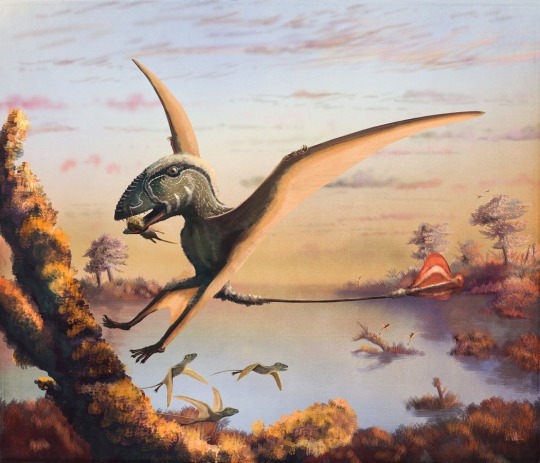
Art credit: Mark Witton
Dimorphodon is a good representative of the rhamphorynchoid pterosaurs. As a hunter, it probably preyed upon small mammals and reptiles. It had a one-and-a-half metre (4ft) wingspan, roughly the height of a person. As it and its relatives predated birds by tens of millions of years, whereas other pterosaurs lived alongside birds, they would have had the airspace all to themselves, and would have been the only flying vertebrates flitting from tree to tree. Rhamphorynchoid pterosaurs are unfortunately not a diverse group, so dimorphodon is the only member I will include.

Art credit: Julius Csotonyi and Alexandra Lefort
Quetzalcoatlas is notable for being the largest flying animal of all time. When standing, they were 6 metres (18ft) tall, or as tall as a giraffe. When flying, they had an estimated wingspan of 10 metres (34ft), the size of a small fighter jet. They were so big that there have been some debates over whether or not they could even fly. They were probably predators or scavengers, either chasing after their prey on the ground or gliding huge distances to find the remains of giant dinosaurs. Quetzalcoatlas’ relative, hatzegopteryx, may have been the apex predator of the island it lived on. It’s so cool to think about the sheer size of the biggest flyers that ever existed.

Art credit: Adrian Gonzalez
Tapejara was a small pterosaur from Cretaceous Brazil. Unlike many other crested pterosaurs, the majority of of tapejara’s crest was not made of bone, but of a membrane of skin. One thin bone in the front of the crest supported a structure unknown in size and shape. It had the same metre-and-a-half wingspan of Dimorphodon, but unlike Dimorphodon, it had to compete with other small flyers- birds.
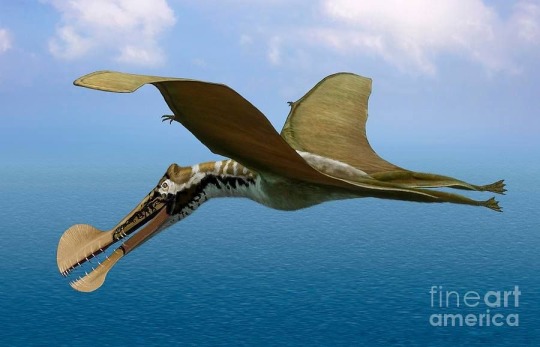
Art credit: Sergey Krasovskiy
Tropeognathus is known for its odd-looking jaw. Not only was it one of the only pterodactyloid pterosaur to have teeth, but it had this odd keeled-jaw that it would’ve used to catch fish. It was vaguely related to pteranodon. It’s wingspan was eight and a half metres (27ft), which several sites tell me was the largest pterosaur in the Southern Hemisphere- though take that statistic at your own risk. By the way, that wingspan is still a metre wider than the longest snake ever recorded. I think it’s easy to look at paleoart and forget how big these animals are. When standing, these flyers would’ve been the height of your average person. They may not have been quetzalcoatlas, but they were still massive.
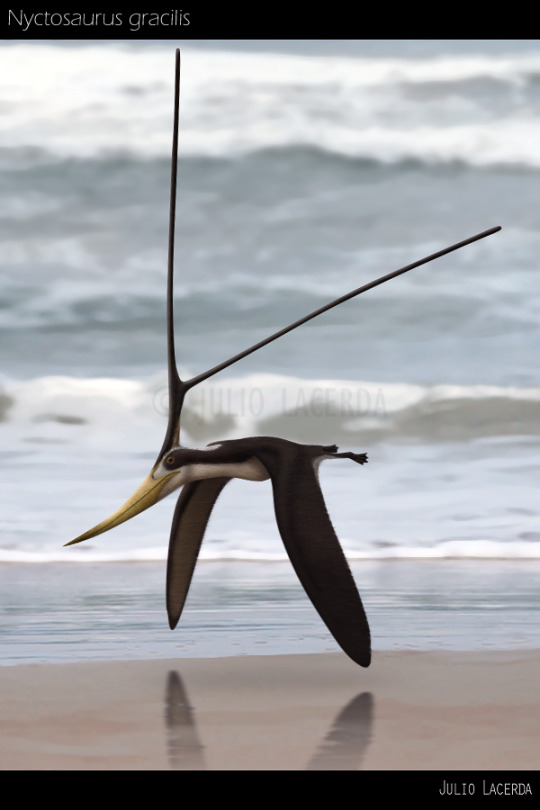
Art credit: Julio Lacerda
Nyctosaurus is another mostly run-of-the-mill fish-eating pterosaur. It was quite small, with only a 2 metre (6ft) wingspan. What sets nyctosaurus apart is its ridiculously extravagant head crest. There’s a running joke in palaeontology circles that any structure on an animal with an unknown purpose will simply be labelled as a display structure- nyctosaurus is my favourite example of this. It seems laughable that any animal would evolve such a large, possibly inconvenient structure for no other reason to attract a mate, and yet every other explanation has been tossed out. I sometimes see this head crest restored with a membrane between the points, like tapejara’s soft tissue crest, but unlike tapejara, nyctosaurus does not seem to have grooves in the bone that would implicate a soft tissue crest.
Thank you all for coming along with me on this journey throughout the world of pterosaurs! They’re such an interesting group of animals, and I wish more people were as fascinated with them as I am. But, I suppose, let this post be an introduction to pterosaurs that sparks your imagination enough to look into them more. I hope you enjoyed being educated, and have a great night!
415 notes
·
View notes
Note
Do you have a favorite pterosaur? My favorite is nyctosaurus. Also, i think it's really neat how they might've occupied completely different ecological niches throughout their lifespan! { tetzoo. com/ blog/ 2021/ 7/ 21/ baby-pterosaurs-were-excellent-fliers-and-occupied-different-niches-from-their-parents }
Much too difficult to pick a favorite, but I’m a fan of the rhamphorhynchoid pterosaurs, like Scaphognathus:

Like a duck penguin with a face full of knives. Incredible
49 notes
·
View notes
Text
Orang Bati

The Orang Bati has an ape-like body, much like a human standing four to five feet tall, with red skin on its body. The creature has large black leathery wings and a long tail, compared to rhamphorhynchoid species of flying dinosaurs or pterosaurs. Some accounts describe the wings and tail as covered with thick black fur. Villagers often hear the Orang Bati's arrival by the sound of its shrill wail, similar to that of pterosaurs.
The Orang Bati - Indonesia's Winged Man
24 notes
·
View notes
Photo

Rhamphorhynchus 01
Late Jurassic, Europe
A pair of Rhamphorhynchus pterosaurs in the first light of dawn.
Made in Blender.
#paleontology#paleoart#pterosaur#Jurassic#late jurassic#Rhamphorhynchus#rhamphorhynchoid#rhamphorhynchid#pycnofibers#dawn#dusk#Nathan E. Rogers#blender#3d#prehistoric#solnhofen
36 notes
·
View notes
Video
youtube
Let's meet the Pterosaurs for #Fossilfriday. They were flying reptiles that existed at the same time as the Dinosaurs, but they were in fact not dinosaurs - flying reptiles. Original caption:
"Pterosaurs were flying reptiles of the extinct clade or order Pterosauria. They existed during most of the Mesozoic: from the late Triassic to the end of the Cretaceous (228 to 66 million years ago). Pterosaurs are the earliest vertebrates known to have evolved powered flight. Their wings were formed by a membrane of skin, muscle, and other tissues stretching from the ankles to a dramatically lengthened fourth finger.
There were two major types of pterosaurs. Basal pterosaurs (also called 'non-pterodactyloid pterosaurs' or ‘rhamphorhynchoids’) were smaller animals with fully toothed jaws and, typically, long tails. Their wide wing membranes probably included and connected the hind legs. On the ground, they would have had an awkward sprawling posture, but their joint anatomy and strong claws would have made them effective climbers, and they may have lived in trees. Basal pterosaurs were insectivores or predators on small vertebrates. Later pterosaurs (pterodactyloids) evolved many sizes, shapes, and lifestyles. Pterodactlyoids had narrower wings with free hind limbs, highly reduced tails, and long necks with large heads. On the ground, pterodactyloid walked well on all four limbs with an upright posture, standing plantigrade on the hind feet and folding the wing finger upward to walk on the three-fingered "hand." They could take off from the ground, and fossil trackways show at least some species were able to run and wade or swim. Their jaws had horny beaks, and some groups lacked teeth. Some groups developed elaborate head crests with sexual dimorphism.
Pterosaurs sported coats of hair-like filaments known as pycnofibers, which covered their bodies and parts of their wings. Pycnofibers grew in several forms, from simple filaments to branching down feathers. These are homologous to the down feathers of birds and some dinosaurs, suggesting that early feathers evolved in the common ancestor of pterosaurs and dinosaurs, possibly as insulation. In life, pterosaurs would have had smooth or fluffy coats that did not resemble bird feathers. They were warm-blooded (endothermic) active animals. The respiratory system had efficient unidirectional "flow-through" breathing using air sacs, which hollowed out their bones to an extreme extent. Pterosaurs spanned a wide range of adult sizes, from the very small anurognathids to the largest known flying creatures of all time, including Quetzalcoatlus and Hatzegopteryx, which reached wingspans of at least nine meters. The combination of endothermy, good oxygen supply, and strong muscles allowed pterosaurs to be powerful and capable flyers.
Pterosaurs are often referred to by popular media or the general public as "flying dinosaurs", but dinosaurs are defined as the descendants of the last common ancestor of the Saurischia and Ornithischia, which excludes the pterosaurs. Pterosaurs are nonetheless more closely related to birds and other dinosaurs than to crocodiles or any other living reptile, though they are not bird ancestors. Pterosaurs are also colloquially referred to as pterodactyls, particularly in fiction and by journalists. However, technically, pterodactyl only refers to members of the genus Pterodactylus, and more broadly to members of the suborder Pterodactyloidea of the pterosaurs.
Pterosaurs had a variety of lifestyles. Traditionally seen as fish-eaters, the group is now understood to have included hunters of land animals, insectivores, fruit eaters and even predators of other pterosaurs. They reproduced by means of eggs, some fossils of which have been discovered."
71 notes
·
View notes
Photo

Caviramus schesaplanensis, a pterosaur from the Late Triassic of Switzerland (~205 mya). Known from two fossil specimens -- a partial jaw and a much more complete skull and skeleton -- it was about the size of a modern raven, with a length of around 60cm (2′) and a wingspan of 1.35m (4′5″).
(The more complete fossil is also sometimes considered to be a separate genus and species, Raeticodactylus filisurensis, depending on which pterosaur specialist you ask. If it was a different animal it still would have been very closely related to Caviramus, though, and the two would likely have looked very similar to each other.)
It had some odd anatomy for an early pterosaur, with proportionally long and slender limbs and a fairly heavily-built skull. There were bony crests on both its upper and lower jaws, with the upper crest probably supporting a much larger soft-tissue structure.
Powerful jaw muscles along with a combination of fang-like teeth at the front of its jaws and and serrated slicing-chewing teeth further back suggest it was specialized for eating particularly tough foods such as hard-shelled invertebrates -- and it may even have been omnivorous, capable of eating plant matter as well.
#science illustration#paleontology#paleoart#palaeoblr#caviramus#raeticodactylus#non-pterodactyloid pterosaur#'rhamphorhynchoid'#pterosaur#archosaur#art#triassic
386 notes
·
View notes
Note
Is there a scientific term for the tail ornaments on rhamphorhynchoid pterosaurs?
From what I’ve seen, they’re generally known (straightforwardly enough) as “tail vanes”.
3 notes
·
View notes
Text
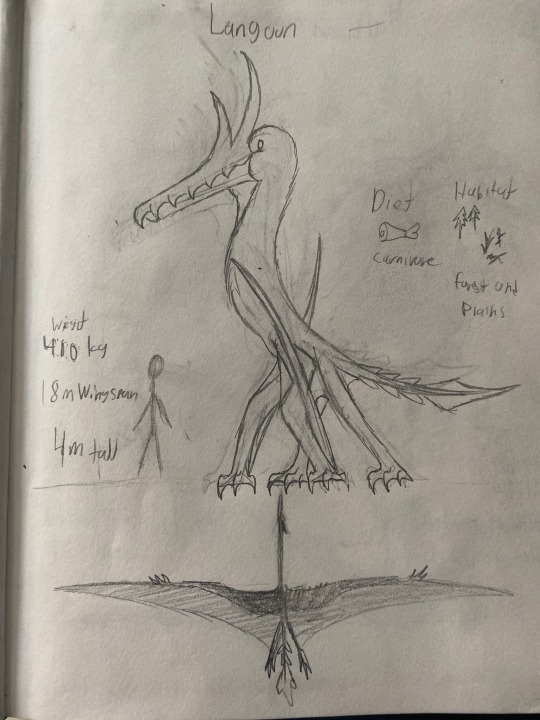
the largest animal ever to fly the great lance dragon or langoon are giant Rhamphorhynchoid pterosaurs that rule over saikin with a serrated beak and powerful claws these animals are capable of hunting prey up to a ton or more in weight The langoon are most similar to the long extinct azdarchids in appearance and indeed hunt on the ground in a similar fashion yet perhaps surprisingly these animals are far closer to Genera like Harpactognathus than any Azdarchoid
langoon are known to mate for life with males building nests to impress females if the female deems his nest building skills acceptable she will chose him as a lifelong mate they are also unique as being a pterosaur that actively care for their young they have few offspring but the young have a far greater chance at survival this way
26 notes
·
View notes